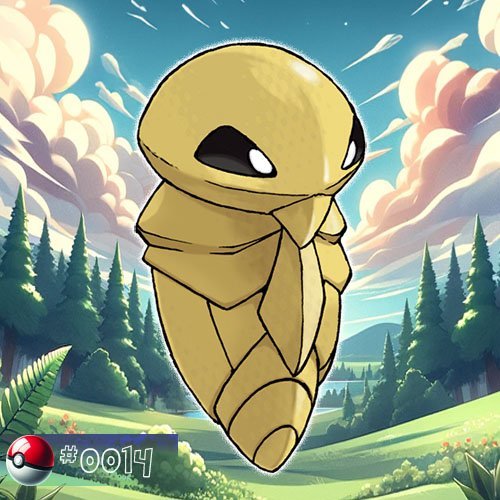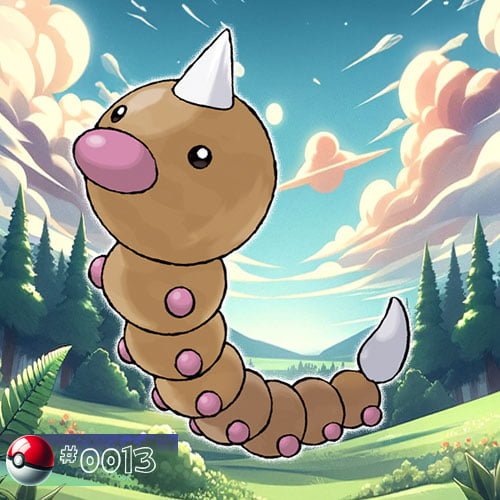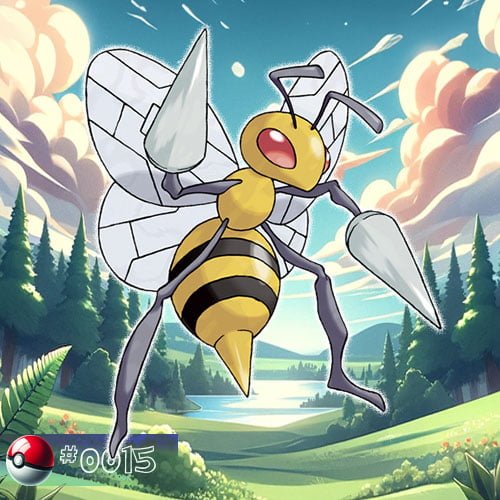Kakuna
Kakuna is a Pokémon species in the Pokémon franchise, known for its cocoon-like appearance. The Pokémon is characterized by its shell-like structure, reflecting its pupal state, and it is associated with Bug-type moves and characteristics in the Pokémon games and animated series.
Biology
Physical Characteristics
Kakuna is an insectoid Pokémon characterized by its cocoon-like appearance. Kakuna has a hard, cocoon-like firm and resilient shell that protects its body during the evolution process.
The outer shell of Kakuna is typically yellow or beige, with a distinct hard texture.
The upper part of Kakuna’s shell is black, housing a face with two beady, black eyes visible through small openings in its shell that suggest the dormant nature of the Pokémon within.
With short, stubby arms visible on its sides, Kakuna exhibits limited physical features as it undergoes the process of metamorphosis. Kakuna lacks distinct limbs, as it is in a transitional stage between Weedle and Beedrill evolution.
Kakuna is relatively small in size, and its shape is similar to that of a chrysalis or cocoon.
Remember that Kakuna is an intermediate stage in the evolutionary line, and its characteristics reflect its role in the transformation process from Weedle to Beedrill.
Behaviour
Kakuna is known for its passive and dormant behavior, primarily due to its state of metamorphosis. Encased within its hard cocoon shell, Kakuna remains largely immobile and defenseless. It spends the majority of its time hanging from tree branches or other structures, conserving energy as it undergoes the transformation from Weedle.
During this period, Kakuna is highly vulnerable to predation, relying solely on its protective shell to ward off potential threats. It does not actively seek out food or engage in any significant movement. Instead, Kakuna patiently awaits the completion of its metamorphosis, signaling the emergence of its more formidable form, Beedrill.
While dormant, Kakuna can exhibit some minor reflexive actions, such as twitching or vibrating its shell in response to external stimuli. However, these movements are sporadic and serve primarily as automatic responses rather than purposeful behavior.
Overall, Kakuna’s behavior is characterized by its passive and inert nature, reflecting its role as a transitional stage in the evolutionary cycle of Weedle.
Evolution
Weedle Stage
Weedle is the initial larval stage in the evolutionary line. It resembles a small, caterpillar-like Pokémon with a needle-like stinger on its head.
Kakuna Stage
Upon reaching a certain level of maturity, Weedle undergoes metamorphosis into Kakuna. This phase at level 7 is characterized by the Pokémon encasing itself in a hard cocoon or shell.
Kakuna retains the general body shape of Weedle but is covered in a tough, chitinous outer layer. It hangs from branches or other structures during this dormant stage. Kakuna serves as a protective vessel, allowing internal changes to take place as it prepares for the final stage of evolution.
Beedrill Stage
After a period of time in the Kakuna stage, the Pokémon emerges as Beedrill at level 10. Beedrill is a large, bee-like Pokémon with formidable stingers on its forelimbs.
The evolution results in a significant increase in size, strength, and offensive capabilities. Beedrill is known for its agility and the ability to deliver powerful Poison-type attacks.
The evolution from Kakuna to Beedrill signifies the completion of Weedle’s transformation into a fully developed and more formidable Pokémon. This natural progression allows the Pokémon to adapt to different environments and engage in a wider range of behaviors and interactions.
Appearances
Anime Main Appearances
In the Pokémon anime episode titled “Challenge of the Samurai”, Ash Ketchum, our aspiring Pokémon Trainer, encounters Kakuna during his journey in the Viridian Forest. This episode is part of the early adventures in the Indigo League saga.
Ash encounters a skilled Trainer known as the Samurai, who challenges him to a battle. The Samurai is known for his Bug-type Pokémon, and his team includes a Kakuna. Kakuna is introduced when Samurai sends it into battle, showcasing the diversity of Bug Pokémon in the Viridian Forest. Kakuna undergoes a significant transformation – it evolves into Beedrill during the battle.
Anime Minor Appearances
Kakuna, being a stage in the evolutionary line of Weedle, is not prominently featured in minor appearances across the Pokémon anime. However, it occasionally makes brief appearances in various episodes, often as part of a larger group or in the background.
Several Kakuna made notable appearances throughout various episodes:
- In “A Chansey Operation” and in ”Pikachu’s Vacation” (at the Pokémon Theme Park) Kakuna featured.
- Multiple Kakuna appeared in “Showdown at the Po-ké Corral”, ”Mewtwo Returns”, ”Gettin’ The Bugs Out” (living at the Azalea Gym), “A Poached Ego!” and “All in a Day’s Wurmple”
- In “Illusion Confusion!”, a Kakuna was among the illusions created by Haunter and Gengar.
- Kakuna evolved into Beedrill in “The Grass-Type Is Always Greener!” and “Danger, Sweet as Honey!”.
- In “All Dressed Up With Somewhere To Go!”, a Kakuna disguised as a Crawdaunt for a Pokémon Dress-Up Contest.
- Kakuna appeared in “I Choose You!”, “Enter Pikachu!”, and “Legend? Go! Friends? Go!”.
- Goh caught a Kakuna in “Working My Way Back to Mew!”, which has since been seen in subsequent episodes of ”Pokémon Journeys: The Series”.
- Additionally, a Trainer’s Kakuna appeared in “Take My Thief! Please!” and “The Road Most Traveled!”, where it evolved into Beedrill.
Manga Appearances
These manga appearances provide a diverse portrayal of Kakuna, showcasing its involvement in various storylines, battles, and interactions with different characters.
Magical Pokémon Journey
Episode: How Do You Do, Pikachu? – A Kakuna makes an appearance in this manga series, contributing to the magical and whimsical world.
Pokémon Adventures – Red, Green & Blue arc
Episode: Bulbasaur, Come Home! – Kakuna debuts in a cameo appearance, escaping from Professor Oak’s Laboratory along with other Pokémon.
Pokémon Adventures – Gold, Silver & Crystal arc
Episode: Murkrow Row – A Kakuna is featured in Gold’s house, known as the House of Pokémon, showcasing the diverse Pokémon residing there.
Episode: Ursaring Major – Bugsy, the Azalea Town Gym Leader, utilizes two Kakuna on his team, one of which first appears in this episode. They visit Azalea Town’s well with a Metapod.
Pokémon Adventures – Platinum arc
Episode: Softening Up Kakuna – A Kakuna is used by a Trainer challenging the Battle Factory, highlighting its battle capabilities.
Pokémon Adventures – The Last Battle XIII
Kakuna is among the Pokémon sent to participate in the fight in Ilex Forest, showcasing its involvement in significant events.
Pokémon Gold & Silver: The Golden Boys
Episode: Let’s Aim For The Goal – Bugsy is depicted with a Kakuna, showcasing its continued presence in Bugsy’s team.
Pokémon Gotta Catch ‘Em All
Episode: Catch the Poliwag! – A Kakuna appears in a background collage, adding to the collection of Pokémon featured in this manga.
Pokémon Journeys: The Series
Episode: Legend? Check! Friends? Check! – Two Kakuna make an appearance in this series, contributing to the Pokémon diversity highlighted in the manga.
Episode: Battle Frontier Challenge: The Flute Cup! – Goh catches a Kakuna, similar to his action in the anime, showcasing consistency across different Pokémon media.
Pokémon Pocket Monsters
Episode: Catch That Pokémon Thief!! – A Kakuna makes an appearance in this manga episode, possibly involved in a specific scenario or event.
Episode: The Hardest Bug Pokémon Wins?! – Bugsy owns a Kakuna, adding to the challenges faced in a bug-type competition.
Pokémon Ruby-Sapphire
Episode: I Won’t Let You Lead!! – A Kakuna appears in this manga series, potentially playing a role in the plot or events.
Game data
Stats
Location
| Game version | Location |
|---|---|
| Pokémon Red | Routes 24, and 25, Viridian Forest |
| Pokémon Blue | Routes 25, Viridian Forest |
| Pokémon Yellow | Trade |
| Pokémon Gold | National Park (Bug-Catching Contest) |
| Pokémon Silver | Route 2, 26, 27, 30, 31, 34, 35, 36, 37, 38, 39, Azalea Town, Ilex Forest, Lake of Rage, National Park (Bug-Catching Contest) |
| Pokémon Crystal | Routes 2, 24, 25, Route 30, and Route 31, Ilex Forest, National Park (Bug-Catching Contest) and Lake of Rage (Headbutt trees) |
| Pokémon Ruby and Pokémon Sapphire | Trade |
| Pokémon FireRed and Pokémon LeafGreen | Route 24, 25, Pattern Bush, Viridian Forest |
| Pokémon Emerald | Trade |
| Pokémon Colosseum | Trade |
| Pokémon XD: Gale of Darkness | Trade |
| Pokémon Diamond and Pokémon Pearl | Eterna Forest |
| Pokémon Platinum | Eterna Forest |
| Pokémon HeartGold | National Park (Bug-Catching Contest) |
| Pokémon SoulSilver | Route 2, 30, 31, 47, Ilex Forest, National Park, Viridian Forest |
| Pokémon Black | Route 12 |
| Pokémon White | Trade |
| Pokémon Black 2 | Evolve Weedle |
| Pokémon White 2 | Trade |
| Pokémon X | Santalune Forest, Friend Safari (Poison) |
| Pokémon Y | Friend Safari (Poison) |
| Pokémon Omega Ruby and Pokémon Alpha Sapphire | Safari Zone |
| Pokémon Sun and Pokémon Moon | Trade |
| Pokémon Ultra Sun Pokémon Ultra Moon | Evolve Weedle |
| Pokémon: Let's Go, Pikachu! and Pokémon: Let's Go, Eevee! | Viridian Forest |
| Pokémon Sword and Pokémon Shield | Unobtainable |
| Pokémon Brilliant Diamond | Trade |
| Pokémon Shining Pearl | Evolve Weedle |
| Legends Arceus | Unobtainable |
| Pokémon Scarlet and Pokémon Violet | Unobtainable |
Kakuna 's origin name
The naming across languages predominantly revolves around the Pokémon’s cocoon stage, emphasizing its protective shell during the evolution process.
English: The name “Kakuna” in English is derived from a combination of “cacoon” and possibly “kabuto” (Japanese for helmet), reflecting its transformation into a protective shell during the evolution process.
Japanese (カクーン – Kakūn): The Japanese name Kakūn (カクーン) closely mirrors the English name and emphasizes its cocoon-like form. The pronunciation remains consistent across languages.
German: In German, Kakuna retains its English name, further emphasizing the cocoon aspect of its form.
French: The French name for Kakuna is also Kakuna, maintaining the international consistency in the Pokémon’s name.
Spanish: Kakuna’s name in Spanish is, once again, Kakuna, aligning with the English and Japanese names.
Italian: Similarly, Kakuna’s Italian name is Kakuna, staying true to the global nomenclature.
Korean (딱충이 – Ddakchungi): The Korean name Ddakchungi incorporates elements that sound similar to the English “bug” (딱딱 – ddakddak) and “caterpillar” (충이 – chungi), capturing its insect-like nature.
Chinese (甲壳蛹 – Jiǎké Yǒng): In Mandarin Chinese, Kakuna is known as Jiǎké Yǒng, where “甲壳” (Jiǎké) refers to a shell or armor, and “蛹” (Yǒng) means pupa or chrysalis.





